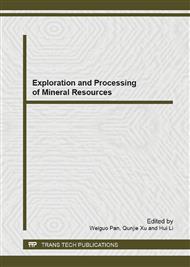[1]
International energy agency: Coal in the Energy Supply of China. The 25th coal industry advisory board asia committee.
Google Scholar
[2]
H J Liu, S X Sang, Y H Guo, et al.: Acta Sedimentologica Sinica. Vol. 01 (2003), pp.129-132. (in chinese).
Google Scholar
[3]
K C Zhou, Z X Hu, D Z Gao, et al.: Utilization of Mineral Resources. Vol. 05 (1996), pp.20-24. (in chinese).
Google Scholar
[4]
Y G Tang, D Y Ren, Q P Liu, et al.: Acta Sedimentologica Sinica. Vol. 04 (1996), pp.162-168. (in Chinese with English abstract).
Google Scholar
[5]
X C Wang, Y C Zhang, R Q Pan, et al.: Sedimentary Environments and Coal Accumulation of Late Permian Coal Formation in Western Guizhou, Southern Sichuan and Eastern Yunnan, Chongqing Univ. Press, China. (1996). (in Chinese with English abstract).
Google Scholar
[6]
W H Li: Analysis and Utilization of coal. Vol. 02 (1986), pp.27-37.
Google Scholar
[7]
Z M Zhu, C Chen, Z S Yin: Coal Science and Technology. Vol. 07 (2010), pp.104-108. (in Chinese with English abstract).
Google Scholar
[8]
B S Zheng, Z H Ding, R G Huang, et al.: International Journal of Coal Geology. Vol. 40 (1999), p.119–132.
Google Scholar
[9]
X Y Tang, W H Huang: Trace elements in coal in China. The Commercial Press, (2004). (in Chinese).
Google Scholar
[10]
S F Dai, D Y Ren, C L Chou, et al.: International Journal of Coal Geology. Vol. 94 (2012), pp.3-21.
Google Scholar
[11]
M P Ketris, Y E Yudovich: International Journal of Coal Geology. Vol. 78 (2009), pp.135-148.
Google Scholar
[12]
D Y Ren, F H Zhao, S F Dai, et al.: Geochemistry of Trace element in coal. Science Press, (2006).
Google Scholar
[13]
Y P Zhou: Coal Geology & Exploration. Vol. 03 (1994), pp.17-22.
Google Scholar
[14]
J Y Zhang: Enrichment regularity and polluting suppression of Potentially toxic trace elements in coal. China University of Mining and Technology, Beijing, (1999).
Google Scholar
[15]
Y E Yudovich, M P Ketris: International Journal of Coal Geology. Vol. 61 (2005), pp.141-196.
Google Scholar
[16]
F H Zhao: Study on the Meehanism of Distributions and occurrenees of Hazardous Minor and Trace Elements in Coals and Leaching Experiments of Coal Combustion Residues. China University of Mining and Technology, Beijing, (1997).
Google Scholar
[17]
R B Finkelman, C A Palmer, M R Krasnow, et al.: Energy & fuels. Vol 6(1990), pp.755-766.
Google Scholar


